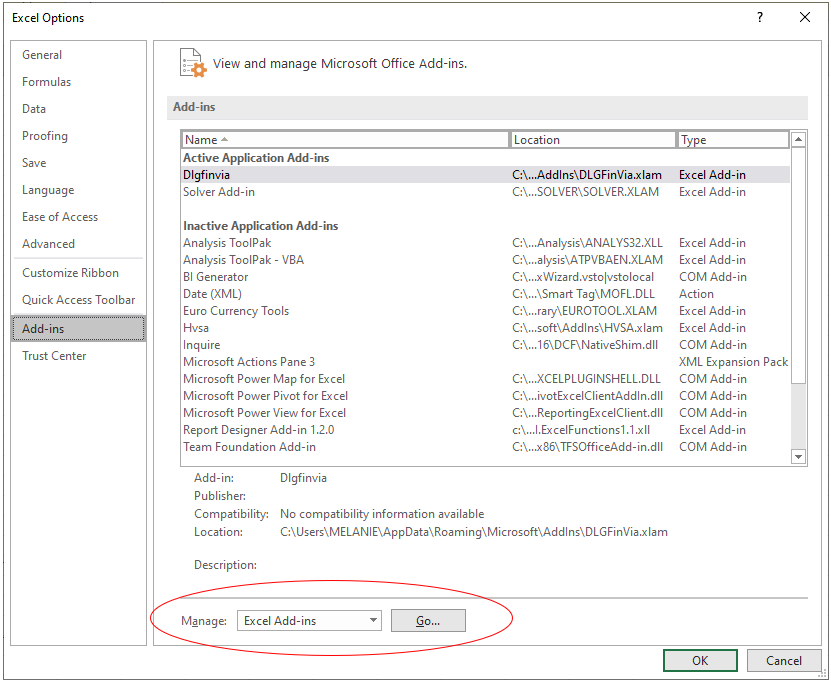

- #Excel solver function in vba 2013 how to
- #Excel solver function in vba 2013 full
- #Excel solver function in vba 2013 code
#Excel solver function in vba 2013 code
The code identifies how many times the action will be performed in a sequence ( varButton) and the increment value used to iterate through the sequence ( Step).

This example contains all of the typical criteria needed to complete a For Loop using VBA, however. You could nest the For Loop within other logical tests, such as a Do While or If statement. You could, however, add additional actions to perform at this point, such as changing another cell’s value or creating a different pop-up message. Once the end value is reached, the loop exits and the macro stops. For instance, changing this to 5 would mean only three pop-ups appear. By default, the values increase by 1 (starting with 0, 1, 2, etc) but this can be changed by adding a Step value. As the test has a start and end variable, the loop has a finite number of runs before it finishes. The action of pressing the button begins the loop. It then repeats this 9 more times until the varButton variable ( 10) is reached. This pop-up box displays the current variable, starting with zero. Pressing the button causes a pop-up box to appear a set number of times, in sequence, using the variable varButton as the end number (in this case, 10).


As VBA For Loops are useful for finite repetitive actions, let’s assume you want a pop-up to appear when you press a button (with the class name Button). We’ll explain the process using a simple-to-understand example. Introducing a For Loop into the mix allows you to set your code (or part of your code) to repeat itself a certain number of times. Let’s assume that you already have an idea in mind as to how your VBA macro should work.
#Excel solver function in vba 2013 full
While this guide isn’t a full VBA tutorial (and it assumes you have a certain level of basic VBA experience already), it should allow you to create basic VBA loops using For to repeat an action in sequence. This is a basic example, but For Loops are powerful enough to perform almost any action you desire in Excel repeatedly. In this example, the VBA macro is designed to insert values into cells in column A, from 1 to 10, and increase in single-digit increments. A1, A2, A3, etc) until an end value is reached.įor instance, the VBA code snippet shown previously demonstrates such an action. For instance, if you had a macro (written in VBA) that inserted values into a column, you could use a For Loop to do so, filling each cell sequentially (eg. In VBA, a For Loop repeats an action (or set of actions) for a set number of times in a sequence. A loop could also be combined with other statements, such as For and If, that help to determine how often, and for how long, a script should run. Loops are flexible tools, giving you the option to repeat a certain action (such as changing cell values) a set number of times. They help to refract your code, reducing the number of specifically-coded actions that are written to help improve the speed and efficiency of your applications. What are VBA For Loops in Microsoft Excel and what are they used for?Īs we’ve mentioned already, loops are a programming concept that allows a program to repeat itself. How do VBA For Loops work in Excel? Let’s get familiar with the basics.
#Excel solver function in vba 2013 how to
How to add a VBA For Loop in Excel using the Visual Basic Editor.Things to consider before using a VBA For Loop in Excel.What are VBA For Loops in Microsoft Excel and what are they used for?.If you’re new to VBA programming and you’re looking to create a basic (or even advanced) macro using a VBA For Loop, this guide should help you. Using a VBA For Loop is essential for creating macros that will run continuously as you work through your spreadsheet. This could be once a certain calculation is inserted or value reached, or when you perform a certain action in your spreadsheet itself (such as, for instance, pressing a custom-inserted button). For Excel data analysts, a VBA For Loop can allow you to loop through cells or perform a set number of actions once the criteria to do so are met. Loops like this aren’t unique to VBA-indeed, they’re a common feature in most programming languages, allowing a program or script to run continuously in a sequence with a start and end point. For instance, if you want a macro that repeats an action by a certain number of times, you can use a VBA For Loop. VBA is a useful programming language for new data analysts to learn as it supercharges the functionality of Excel, making it easier to perform certain tasks automatically (and repeatedly) with custom-made macro scripts. Macros are automated scripts, typically written using Visual Basic for Applications (VBA), to help you perform certain actions in Excel, such as automate a button press or perform a calculation. If you’re looking to automate your Excel spreadsheets, macros are a good way to do so.


 0 kommentar(er)
0 kommentar(er)
